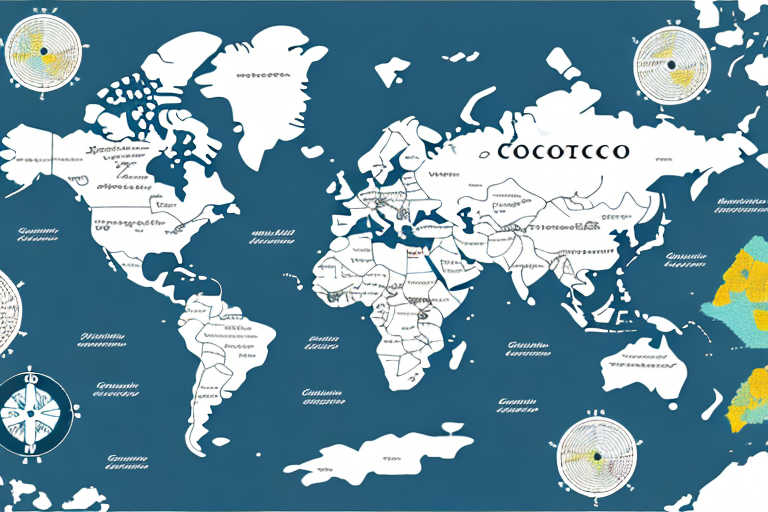Understanding UPS Zone Shipping Rates for 1 Million Items
If you are a business owner or frequently ship items, understanding the fundamentals of UPS zone shipping rates is essential. These rates are complex and can vary significantly based on factors such as destination, weight, and package dimensions. A solid grasp of the UPS shipping system ensures that you are not overpaying for your shipments.
The Basics of UPS Zone Shipping Rates and How They Work
UPS zone shipping rates are determined primarily by the distance between the origin and destination of the package. The United States is divided into various zones by UPS, with each zone representing a different geographical region. Rates are calculated based on the distance between the origin and destination zip codes, determining the zone in which the package falls.
Once a package is assigned to a specific zone, UPS applies a standard rate based on its weight and dimensions. For example, shipping a large package that weighs more than 50 pounds may place it in a higher rate tier, resulting in higher shipping costs.
UPS also offers various shipping options that can affect the cost. Expedited shipping services, which ensure faster delivery, typically cost more than standard shipping options. Additionally, UPS provides discounts for businesses that ship frequently or in large volumes, which can be advantageous for regular shippers.
What Determines UPS Zone Shipping Rates for Different Destinations
While distance between the origin and destination is the primary factor in determining UPS zone shipping rates, other elements also impact the cost. These include the package's weight, dimensions, and the chosen service type (e.g., ground, air, or freight).
Additional factors such as fuel surcharges and other fees can also influence shipping costs. Shipping to remote or rural locations may incur higher costs due to increased distance or limited infrastructure.
UPS frequently offers discounts and promotions to help reduce shipping costs. Businesses that ship often may qualify for volume discounts or special rates. Seasonal promotions or discounts for specific destinations or services can also provide cost savings. It's advisable to check for available discounts or promotions before shipping your items.
The Impact of Package Weight and Dimensions on UPS Zone Shipping Rates
Package weight and dimensions are crucial in determining UPS zone shipping rates. UPS employs a dimensional weight calculation method, which considers both the actual weight and the package's size to determine the total shipping cost.
For instance, shipping a small but heavy package may result in higher costs compared to a larger package that weighs less. Accurately measuring and weighing your items before shipping is essential to avoid extra charges for overweight or oversized packages.
The destination of the package also affects shipping rates. Shipping to a remote or rural area can lead to higher costs due to additional distance and transportation expenses. It is important to consult the UPS zone map and review shipping rates for your specific destination before sending your package.
UPS offers various shipping options, including ground, air, and international services, each with different rates and delivery times. Selecting the right shipping option can help you save money and ensure timely delivery. Comparing rates and delivery times across different shipping options is recommended before making a decision.
How to Calculate UPS Zone Shipping Rates for Large Volume Shipments
For businesses that ship large volumes of items, qualifying for shipping discounts can lead to significant cost savings. To be eligible, you typically need to enter into a UPS agreement for a minimum annual shipping volume and meet other criteria.
Once enrolled in a UPS agreement, you can access discounted rates that vary based on service levels and the origin/destination zones of your packages.
To calculate UPS zone shipping rates for large volumes, determine the origin and destination zones of your packages using the UPS Zone Locator tool on the UPS website. Enter the zip codes of the origin and destination locations to obtain the corresponding zone numbers.
With the zone numbers identified, refer to the UPS Rate and Service Guide to find applicable rates for your shipments. The guide provides detailed information on rates for each service level, including any additional fees or surcharges that may apply.
Tips for Reducing UPS Zone Shipping Costs for Your Business
- Consolidate Your Shipments: Combine multiple packages into a single shipment to reduce the number of packages you ship.
- Optimize Packaging: Use packaging that minimizes weight and dimensions to lower shipping costs.
- Negotiate Rates: Work with UPS to negotiate better rates based on your shipping volume.
- Use Third-Party Logistics: Outsourcing your shipping to a third-party logistics provider can help reduce costs.
- Leverage Regional Carriers: Use regional carriers for certain zones to take advantage of lower rates.
Additionally, taking advantage of UPS's various discounts and promotions can further reduce shipping costs. Regularly reviewing and analyzing your shipping data can help identify areas for optimization, such as adjusting shipping frequency, changing packaging materials, or exploring alternative shipping methods like ground versus air shipping.
Understanding the Differences Between UPS Ground, Air, and Freight Services
UPS offers several shipping services tailored to different needs, including ground, air, and freight services. Each service has unique characteristics designed to cater to specific customer requirements.
UPS Ground service is a cost-effective method for delivering parcels within the US. UPS Freight service is intended for heavyweight shipments that require special handling or are oversized.
UPS Air service offers faster delivery options but at a higher cost. UPS also provides additional services such as signature confirmation, insurance, and Saturday delivery. Signature confirmation ensures that the recipient signs for the package upon delivery, while insurance provides coverage for lost or damaged packages. Saturday delivery is an option for those needing weekend deliveries.
Factors to Consider When Choosing Between UPS Zone Shipping Options
When selecting UPS zone shipping options, consider factors such as time, cost, and the level of service required.
- Delivery Speed: Choose air services for quick delivery or ground services for more extended timelines.
- Package Weight and Dimensions: Ensure your package size and weight align with the selected shipping option to avoid extra costs.
- Destination Zone: Different zones have varying rates, so accurate zone determination is essential.
- Type of Items: Fragile or valuable items may require additional packaging and handling, affecting cost and delivery time.
- Special Requirements: Consider any customs regulations or delivery restrictions for the destination.
- Carrier Reputation: Research the carrier's reliability and customer service through reviews and feedback.
Choosing the right shipping option ensures cost-effectiveness and timely delivery while meeting the specific needs of your shipment.
Common Mistakes to Avoid When Using UPS Zone Shipping Rates
- Incorrectly Measuring Package Dimensions: Inaccurate measurements can lead to unexpected fees.
- Using the Wrong Zip Code: Ensuring the correct destination zip code is crucial for accurate rate calculation.
- Choosing the Wrong Service Level: Selecting an inappropriate service level can result in higher costs or delayed deliveries.
To avoid these mistakes, always double-check your shipping information and ensure accurate packaging to prevent extra fees or delays.
Best Practices for Negotiating Better UPS Zone Shipping Rates with Carriers
Negotiating better UPS zone shipping rates requires a clear understanding of your shipping patterns and volume. Analyze your shipping data and trends to leverage your shipping volume effectively.
Other strategies include obtaining multiple quotes from competing carriers and presenting them to UPS, demonstrating that you have alternative options. Being prepared to negotiate and clearly understanding your shipping needs and requirements are essential for successful rate negotiations.
Tracking and Managing Your UPS Zone Shipments for Optimal Efficiency
Effective tracking and management of your UPS zone shipments are crucial for optimal efficiency. UPS offers a comprehensive online tracking system that allows you to monitor the progress of your shipments in real-time.
Implementing an inventory management system helps maintain accurate inventory levels, preventing stockouts or shipping delays. Proper tracking and management streamline your supply chain and reduce costs over time.
Comparing UPS Zone Shipping Rates to Other Carriers in the Market
Comparing UPS zone shipping rates with other carriers ensures you are getting the best price for your shipping needs. Competing carriers such as FedEx, DHL, and USPS offer similar shipping services but may have different pricing structures.
By evaluating the rates and services of various carriers, you can make an informed decision and choose the carrier that best suits your business requirements.
The Future of UPS Zone Shipping and What It Means for Businesses
The future of UPS zone shipping is poised to evolve as the shipping industry undergoes significant changes. Businesses should anticipate a greater emphasis on sustainability and eco-friendly shipping methods, alongside an increased demand for faster shipping times.
Staying informed about industry trends and adapting to emerging practices will help businesses remain competitive and meet evolving customer expectations.
Case Studies: Successful Strategies for Optimizing Your Business's UPS Zone Shipping Costs
Numerous case studies highlight successful strategies for optimizing UPS zone shipping costs. Businesses have achieved significant cost reductions and improved their bottom lines through strategies like consolidation, optimization, and rate negotiations.
By studying these success stories, businesses can implement similar methods to enhance their supply chain operations and achieve comparable results.
For more detailed information and tools, visit ShipScience.




















